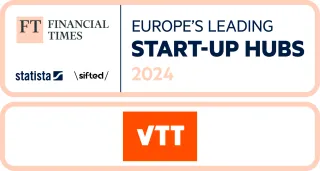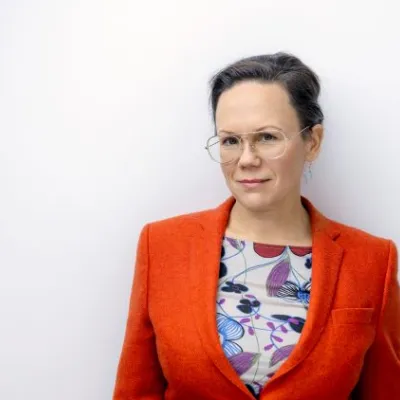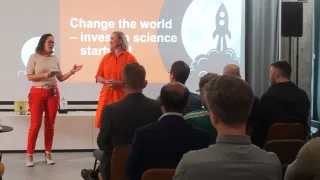At VTT, we focus on maximising the widest possible global impact for the technologies and solutions we have created. VTT’s purpose is to bring together people, business, science and technology to solve the world’s biggest challenges, creating sustainable growth, jobs and well-being. Establishing high-quality, science-based spin-off companies is one option to make this happen. And we have done this with great achievements for example in the fields of food, energy and quantum technology.
What we have learned during the past few years can be crystallised in the following five principles: Aim for global impact. Steer for global impact. Avoid waste. Communicate with clarity. Technology transfer terms for global impact.
Principle 1: Aim for global impact
Since VTT’s task is to create impact for change in society and industry by accelerating renewal, the dominating manner of doing this is via technology transfer. When defining the commercialisation strategy of a VTT-owned technology, we assess how it would create the most powerful impact in terms of renewal. Typically, the impact is created in industrial collaboration as contract research. However, a more radical change of renewing industry can be achieved by spinning off ambitious growth companies. This evaluation helps in finding the route of commercialisation that will create the greatest impact.
Principle 2: Steer for global impact
When the spin-off path has been chosen, we steer our venture teams to aim high and to create an ambitious plan for commercialisation. This is the only way to ensure that the teams have sufficient potential to create great impact. Incubation candidate teams must be able to envision global success as a foundation for their incubation plans. We ask the teams to envision what magnificent global impact they will have created in 10 years with this technology. We also ask them: Where do you need to be in three years to be on the right track? What do you need to do now and with whom should you do it to be on the right path?
The plan can be delivered only when the team itself is great. We spar the team to become the best possible team with high performing individuals and the most desirable future company culture. We also steer the incubation teams to attract the most competitive funding from the best possible investors. This is the only way to ensure the potential to establish great impact. The teams meet investors from the beginning of the incubation, even if the pitch is only a sketch. This way they get to build their network at an early stage and learn how to interact with them.
Principle 3: Avoid waste
In incubation, we help the teams to understand that as entrepreneurs, time is their scarcest resource, and they need to use it wisely only on what is most important to do right now. We steer the incubation teams to rigorously map all assumptions at the core of their business plan and to evaluate them in order to identify the most important assumption they need – solid evidence before anything else of what should be done. This is probably the most tedious task for most teams and is often neglected. This is a pity, since laxness will be reflected in later performance. Time is likely to be wasted on doing unessential things, while critical assumptions remain unvalidated.
Our best teams have mapped and remapped their assumptions, prioritised, and acted immediately when new, contradicting evidence has emerged, and have realigned accordingly.
Principle 4: Communicate with clarity
As an incubator, we need to establish clarity and communicate clearly so that our processes do not create waste. As a company, we need to have clear guidelines on how and under what conditions individuals may establish spin-off companies from VTT, as well as which processes are used to commercialize IPR (Intellectual Property Rights). As an incubator, VTT LaunchPad needs to have a clear description of the process for spin-off incubation that outlines how a team is eligible for incubation, what is expected from the teams during incubation, and when the incubation path is concluded. Finally, we must ensure the incubees agree and commit to complying to the above by signing the incubator undertaking.
The VTT LaunchPad incubator follows the progress of the venture teams with a Venture Readiness Level -model (VRL), inspired by our colleagues at Fraunhofer’s Deeptech Accelerator AHEAD. The VRL is split into Market, Product, Team, Financing and VTT categories and ten progress steps, out of which the Product is the only one that does not need to mature through all ten steps. Finally, our internal funding application is a simple two-page slide deck that, at fastest, can be reviewed in one day.
Principle 5: Technology transfer terms enable global impact and respect the best interests of taxpayers
VTT's approach to ensuring best possible spin-off companies is based on market validation of the venture proposition. During the final stage of incubation, the market validation comes from the capital investors. When the investors are committed to making the required investment to the spin-off, the founding team incorporates the new company. VTT is not part of the founding team.
VTT joins the investors in the investment at the same time, at equal terms and with equal information. Whilst the investors invest capital, VTT invests technology against preferred shares. Typically, VTT post money ownership of the spin-off does not exceed 15%.
With the guiding principle of aiming for impact in mind, VTT does not expect royalty fees, annual payments or other cash-draining compensation from the well-funded spin-offs. The spin-offs are expected to use the cash for executing the ambitious growth plan. For VTT, the financial reward comes from the exit – just like for the capital investors.











